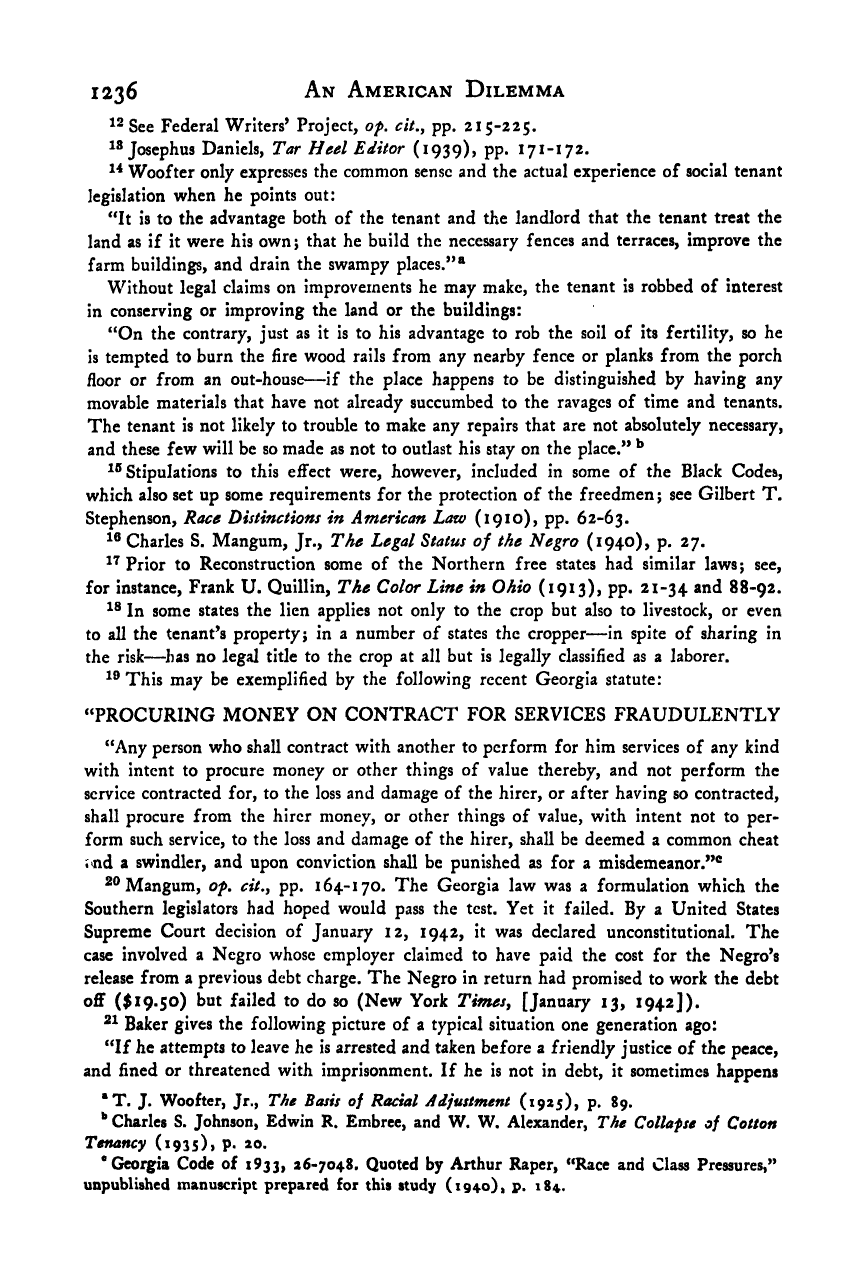Note: Gunnar Myrdal died in 1987, less than 70 years ago. Therefore, this work is protected by copyright, restricting your legal rights to reproduce it. However, you are welcome to view it on screen, as you do now. Read more about copyright.
Full resolution (TIFF) - On this page / på denna sida - Footnotes - Chapter 10

<< prev. page << föreg. sida << >> nästa sida >> next page >>
Below is the raw OCR text
from the above scanned image.
Do you see an error? Proofread the page now!
Här nedan syns maskintolkade texten från faksimilbilden ovan.
Ser du något fel? Korrekturläs sidan nu!
This page has never been proofread. / Denna sida har aldrig korrekturlästs.
An American Dilemma
1236
See Federal Writers^ Project, of, cit,, pp. 215-225.
Josephus Daniels, Tar Heel Editor (1939), pp. 171-172.
1^ Woofter only expresses the common sense and the actual experience of social tenant
legislation when he points out:
‘’It is to the advantage both of the tenant and the landlord that the tenant treat the
land as if it were his own; that he build the necessary fences and terraces, improve the
farm buildings, and drain the swampy places.”*
Without legal claims on improvements he may make, the tenant is robbed of interest
in conserving or improving the land or the buildings:
“On the contrary, just as it is to his advantage to rob the soil of its fertility, so he
is tempted to burn the fire wood rails from any nearby fence or planks from the porch
floor or from an out-house—if the place happens to be distinguished by having any
movable materials that have not already succumbed to the ravages of time and tenants.
The tenant is not likely to trouble to make any repairs that are not absolutely necessary,
and these few will be so made as not to outlast his stay on the place.”
**
Stipulations to this efl’ect were, however, included in some of the Black Codes,
which also set up some requirements for the protection of the freedmen; see Gilbert T.
Stephenson, Race Distinctions in American Law (1910), pp. 62-63.
Charles S. Mangum, Jr., The Legal Status of the Negro (1940), p. 27.
Prior to Reconstruction some of the Northern free states had similar laws; see,
for instance, Frank U. Quillin, The Color Line in Ohio (1913), pp. 21-34 and 88-92.
In some states the lien applies not only to the crop but also to livestock, or even
to all the tenant’s property; in a number of states the cropper—in spite of sharing in
the risk—^lias no legal title to the crop at all but is legally classified as a laborer.
This may be exemplified by the following recent Georgia statute:
“PROCURING MONEY ON CONTRACT FOR SERVICES FRAUDULENTLY
“Any person who shall contract with another to perform for him services of any kind
with intent to procure money or other things of value thereby, and not perform the
service contracted for, to the loss and damage of the hirer, or after having so contracted,
shall procure from the hirer money, or other things of value, with intent not to per-
form such service, to the loss and damage of the hirer, shall be deemed a common cheat
i nd a swindler, and upon conviction shall be punished as for a misdemeanor.”®
Mangum, of, cit,, pp. 164-170. The Georgia law was a formulation which the
Southern legislators had hoped would pass the test. Yet it failed. By a United States
Supreme Court decision of January 12, 1942, it was declared unconstitutional. The
case involved a Negro whose employer claimed to have paid the cost for the Negro’s
release from a previous debt charge. The Negro in return had promised to work the debt
oflf ($19.50) but failed to do so (New York Timesy [January 13, 1942]).
Baker gives the following picture of a typical situation one generation ago:
“If he attempts to leave he is arrested and taken before a friendly justice of the peace,
and fined or threatened with imprisonment. If he is not in debt, it sometimes happens
*T. J. Woofter, Jr., The Basis of Racial Adjustment (1925), p. 89.
**
Charles S. Johnson, Edwin R. Embrce, and W. W. Alexander, The Collafse of Cotton
Tenancy (1935), p. 20.
* Georgia Code of 1933, 26-7048. Quoted by Arthur Raper, “Race and Class Pressures,”
unpublished manuscript prepared for this study (1940), p. 184.
<< prev. page << föreg. sida << >> nästa sida >> next page >>